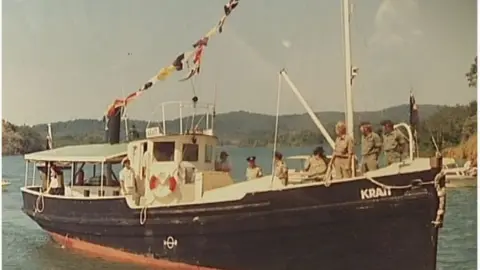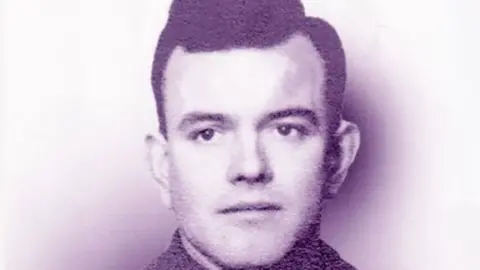World War Two raid on Japanese boats compared to Dambusters
 Evan Morris
Evan MorrisIn one of World War Two's most daring raids, a captured Japanese fishing boat travelled 4,000 miles in 48 days to destroy seven enemy warships.
On board the vessel that left Western Australia for Singapore in autumn 1942 was Ronald "Taffy" Morris from Pentre, Rhondda Cynon Taf.
He joined others from the UK, Australia and New Zealand in Operation Jaywick.
The mission was so secretive that news of the Military Medal (MM) he received was not announced until 1946.
It succeeded in sinking as many Japanese ships in one morning as the Royal Navy achieved in the entire war, and their story was retold in a 1989 mini-series starring Jason Donovan.
Ronald's honours are now expected to fetch up to £80,000 at auction, with his efforts compared to the Dambuster raids.
In his book The Tiger's Revenge, Ronald's son Evan described how his dad, who was born in 1918, left school at 14 to become a miner.
He retired in 1972 as a major in the British Army.
"Dad got back from a day a mile underground, and as the youngest he'd be ninth into the tin bath at home, by then it was stone cold and more coal dust than water," he said.
"I think he just thought there must be more to life than this, and the Army seemed like the logical way out."
 Evan Morris
Evan MorrisIn 1938, he utilised his St John training in the pits to sign up for the Royal Army Medical Corps.
Evan said: "He could have stayed in Pentre - mining was a reserved occupation - but he was desperate to see the world."
He was deployed to Singapore and awarded a British Empire Medal in 1942 after helping to evacuate civilians following the Japanese invasion.
His efforts stuck in the mind of commanding officer Lt Col Ivan Lyon, who called on his services a few months later.
Lyon's vision was to attack the enemy with a captured 40ft (12.2m) wooden Japanese fishing vessel, the Krait - named after a venomous Asian snake.
He planned to disguise the crew as locals, and sail up to the entrance of Singapore Harbour in order to attach magnetic mines to the hulls of the fleet moored there.
The logical place to set off from was British-controlled India, though fears of Japanese spies meant that the departure point was shifted to Australia.
 Noonans
NoonansA 14-strong crew left Exmouth in Western Australia on 2 September 1942, and encountered many problems on the 2,000 mile (3,218km) voyage across the Java Sea.
"They'd barely left Australia when their prop shaft snapped and had to be rewelded by a passing US submarine," said Evan.
"Then a few days later they sailed into a force nine gale, and almost sunk because of the weight of equipment they were carrying with them."
It was once they had cleared Australian water and entered the Lombok Strait things got really dangerous.
Now in enemy waters, they hoisted the Japanese flag. But because it looked too new to be credible, they had to soak it in diesel and scuff it around the deck.
All aboard knew that flying a false flag meant they had crossed the line from combatants to spies, and were therefore outside the protection of the Geneva Convention. If captured they would face certain torture and execution, Evan said.
As such, everyone was issued with a cyanide pill, to provide a kinder and instant death.
 Noonans
NoonansEvan said the ship's skipper had considered giving an amphetamine to maintain the crew's sense of invincibility, but added: "In the end my father's renditions of Men of Harlech and The British Grenadier seem to have been enough.
"I think it was his spirit which earnt him the MM as much as anything."
The pilot of a Japanese patrol plane waved to them, suggesting their cover was good.
There were issues though - Taffy was accidentally shot through the ankle as one of his team cleaned their Lewis machine gun.
He was therefore left aboard as the attack party set off in canoes to paddle the final eight miles (12.8km) into the harbour and set mines.
On 25 September, those who stayed on the ship heard an explosion as 37,000 tons of Japanese shipping sank to the seabed.
There then followed an anxious wait to see if the men returned.
Miraculously, all 14 did, with Ronald's gunshot wound proving to be the only injury sustained.
His eight wartime honours are now set to go under the hammer at auctioneers Noonans.
'Audacity and bravery'
Auctioneer Christopher Mellor-Hill said: "Ordinarily this set of World War Two medals would realise between £3,000 and £4,000, but given the provenance which comes with Ronald Morris's experience, I think the hammer won't go down below £60,000 or £80,000.
"There really won't be another chance to own anything like this ever again, in terms of its audacity and bravery, it's right up there with the Dambusters, even though far fewer people have heard of it."
Evan said he wrote his book to raise funds for veterans who were not as fortunate as his dad, who died in 1999.
On his decision to sell the medals, he said: "I've been too scared to display them.
"I'd never sleep at night knowing they were downstairs - but rather than looking at them once a year, the cash will make a huge difference to my sons' lives.
"I think that's what my dad would have wanted, that's what he was fighting for in the first place."
As part of the auction deal, Mr Morris will receive exact replicas, forged by the same mint that created the originals.
